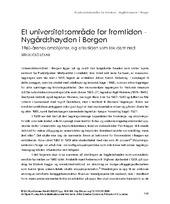| dc.description.abstract | The article investigates the development of a central area in the city of Bergen from the mid 1960s onwards, called Nygårdshøyden. Lying between two harbour areas, Puddefjorden and Vågen, this topographic ridge was pointed out for necessary university expansion. The architectural firm Andersson & Skjånes’ ambitious plans for a university campus which would totally eradicate the existing urban structure, was approved by the municipal government and the university administration. New, effective and flexible building systems had been introduced at university campuses all over the world. In Bergen, some of the buildings originally planned as academic centres were erected according to the plan by Andersson & Skjånes. Others were modified and adapted to changing architectural ideals. The present situation shows clearly how the critique of huge-scale, late-modern architecture had an impact on further developments. Economic and aesthetic aspects combined with an increasing demand for the preservation of historical structures led to modifications of the huge master plans. The dynamics of inserting new architecture into historic neighbourhoods also represent advantages on different levels, creating a diversity of spaces and volumes. The proximity of the university area to the city centre and its urban features represents a quality for students and employees. In the end, large parts of the street pattern of the university area were kept, corresponding with the rest of the city’s building structure. A substantial part of the existing buildings of the area were transformed and adapted to university needs, and new buildings have been raised partly as infill and extension projects. In this way, the planning and development of Nygårdshøyden can tell us a lot about urban development and changing ideals through the last 50 years. In addition, as always when we are looking back, we see that priorities and criteria for preservation or demolition of existing urban structures change all the time. | en_US |

